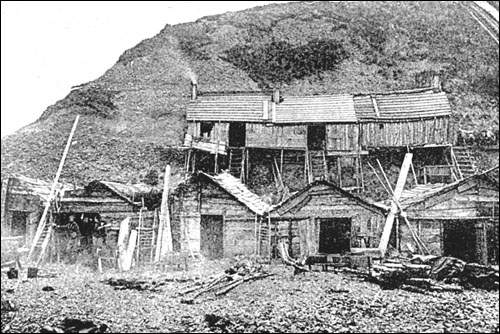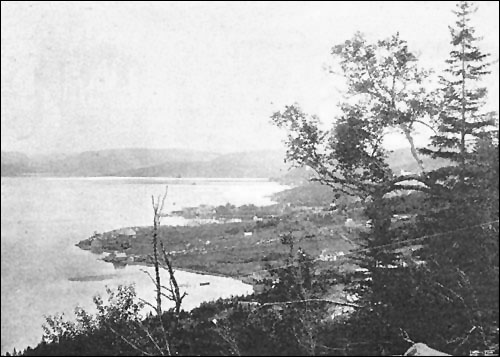West Coast Acadian Francophones
In 1755, the British decided to expel the Acadians from their lands in Nova Scotia, burning their villages and confiscating their possessions. The Acadians in modern-day Nova Scotia, New Brunswick and Prince Edward Island owe their presence to those who, refusing to be dispossessed of their land during what is known in French as the Grand Dérangement, either returned from their places of exile or fled to inland parts until it was safe for them to come out of hiding.
Although the most intense wave of Acadian migration to the west coast of Newfoundland came from Cape Breton Island in the 1840s, it is believed that the first Acadians arrived on Newfoundland's west coast between 1760 and 1780 (Butler 28). It is known that as early as 1770 there were at least two families living in the Stephenville-St. George's area (Thomas 1983 29), and that by 1830 the same area was home to 2000 individuals, of which 1200 were Acadian (de La Morandière 1179). Between 1850 and 1868 nearly 68% of all 750 Catholic births in the Bay St. George region were of Acadian paternity, while another 12% were of French paternity (Mannion 237).
Moreover, by 1850 nearly 80% of the population in the region was French-speaking, if we include the presence of non-Acadian francophones (Butler 32). The francophone population was strong enough to warrant the arrival that same year of a French-speaking priest (Mannion 237).

Acadian Work
While it is clear that the Grand Dérangement was responsible for driving the Acadians out of Acadia, it is not quite so clear what attracted them to the west coast of Newfoundland. They may have come because of the instability in political relations between England and France that had threatened their livelihood and future back on Cape Breton Island (Butler 29). Or, although they would come to rely heavily on agriculture once in Newfoundland, they may have been initially drawn to the west coast of Newfoundland by the cod and herring fisheries (Mannion 234).
During the 19th century, some Acadians fished for cod but most eked out a living as farmers. They cultivated their own vegetables (potatoes, turnip and cabbage) and raised livestock to supply them with meat, butter and milk (Mannion 254). Hunting and fruit-gathering rounded out the Acadians livelihood (Lamarre 144).
French Immigrants
The people who came directly from France accounted for a portion, albeit very small, of the francophone population in the Bay St. George area. Like the French who settled the western extremities of the Port-au-Port peninsula, the French in the bay area were often deserters who either were leaving behind the menial tasks required of them in the French fishery or dodging military service back in France (Mannion 234-235); still others were left behind to keep an eye on fishing installations during the winter months (Butler 34). Unlike the neighbouring Acadians, they were much more prone to early assimilation. Settlement by the French was illegal under the terms of the Treaty of Utrecht, so some may have wanted to conceal their identity by "mixing in" as best they could. Pure loneliness during the long winter season may have led others to marry into English families (de La Morandière 1179). Whatever the case, French males often took English-speaking brides, and in some instances adopted their wives' religion or nationality (Butler 34).
Assimilation
Despite the fact that the Acadians arrived on the west coast in families, assimilation was not too far off for them either, as the great institutions of school and church, responding to the increasing numbers of English-speaking people in the area, were soon to exert their influence.
Stephenville was settled in 1846, but the first school was not established until some 50 years later (Stoker 351). Teaching was carried out in English and students were forbidden to speak French at any time during the school day. It is not surprising that some Acadians belittled their own language, believing that knowing only it, or knowing it at all, was a hindrance to their chances of getting on in the world. With the church being an English-language institution, parents were urged to give their children English names and English became increasingly the language transmitted to children (L'Évangéline 3).
Little is now to be found of francophones in and around the Stephenville-Bay St. George area. French-speaking groups have given way to French-speaking individuals, with the consequence that in these regions French has fallen out of common usage, spoken by a few elderly people at best.
This massive assimilation of the majority of Acadian Newfoundlanders can be attributed largely to the establishment of an American military base in 1941. However, there is evidence that well before 1941 assimilation into the surrounding English-speaking communities was prevalent. Consider the following account of a visit to the west coast of Newfoundland in 1929:
"...one of the characteristics of the afore-mentioned population is the ease with which it becomes anglicized.... at St. George's the altering of family names is frequent and curious. LePours has thus become Power, Beurgeron, Burshell, Benoit, Bennett... Thirty years ago, many of these inhabitants were not able to say one word in English. Today, not only is English understood and spoken ... everywhere, but many children from French families cannot, or no longer want to speak anything but English." (Tricoche 211) [Note: translation by author of present article.]
The same writer, however, does contrast the St. George's area with Stephenville by adding that the influence of assimilation was slower in the latter. Despite the isolation of Acadians in the Stephenville area, some links were still retained with other parts of the French-speaking world. For example, at the time of the trip to Newfoundland described above, some of the older people of the Stephenville area may still have been reading French-language newspapers, such as New York's Le Courrier des États-Unis and Montreal's La Presse (Tricoche 212).
Stephenville, like surrounding areas, would become anglicized. Before 1941, that is before the establishment of the American base, Stephenville had a population that was 95% French-speaking, with a total population of only 1300. Twenty years later, there were only 690 francophones out of a total population of 11,000(Stoker 349,352).
Development in Stephenville
The lives of the Stephenville-area Acadians experienced many changes in a very short period of time, starting at the end of the 19th century with the arrival of the railway and leading up to 1941 with the building of the American base at Harmon Field. The construction of a limestone mine at Aguathuna, just west of the isthmus linking the Port-au-Port peninsula to the mainland, attracted newcomers to the area (Charbonneau 41). A new highway granted outsiders easy access to the settlements, and a number of sawmill operations drew Acadians away from their family-based livelihoods of farming and fishing toward salary-oriented work (Waddell and Doran 151).
The new economic stimulation in the Bay St. George region, facilitated by new infrastructure that allowed for easier access to the area, had led to an influx of English-speaking Newfoundlanders and to a desertion of the traditional way of life in favour of a salary-based economy that privileged the English tongue.
Although French may now only rarely be heard in the Stephenville area, the historical presence of the Acadian French cannot be so easily erased. In fact, several place names on the west coast have an Acadian connection. Stephenville itself, once known as L'Anse-aux-Sauvages, is named after Étienne (the French equivalent of Stephen) Gallant, son of one of its first Acadian inhabitants. The nearby community of Kippens is said to derive from the Acadian pronunciation of the English patronymic Keeping, after a man of this name who owned a sawmill in the area. And the community of Romaines may well owe its name to that of an Acadian family (Thomas 1986 268).

A Moncton newspaper article reported in 1948 that there were some 8000 French-speaking people occupying the area between the Grand Codroy River and the Bay of Islands (L'Évangéline 3). Today, mailboxes in Corner Brook, Stephenville, Stephenville Crossing, Kippens, St. George's and down into the Codroy Valley continue to bear witness to the Acadian presence, as names such as Aucoin, Benoit, Blanchard, Bourgeois, Chaisson, Cormier, Doucet(te), Gallant and Leblanc are common today, existing either in the original Acadian or in the corresponding anglicized form (Thomas 1982 25-31).




